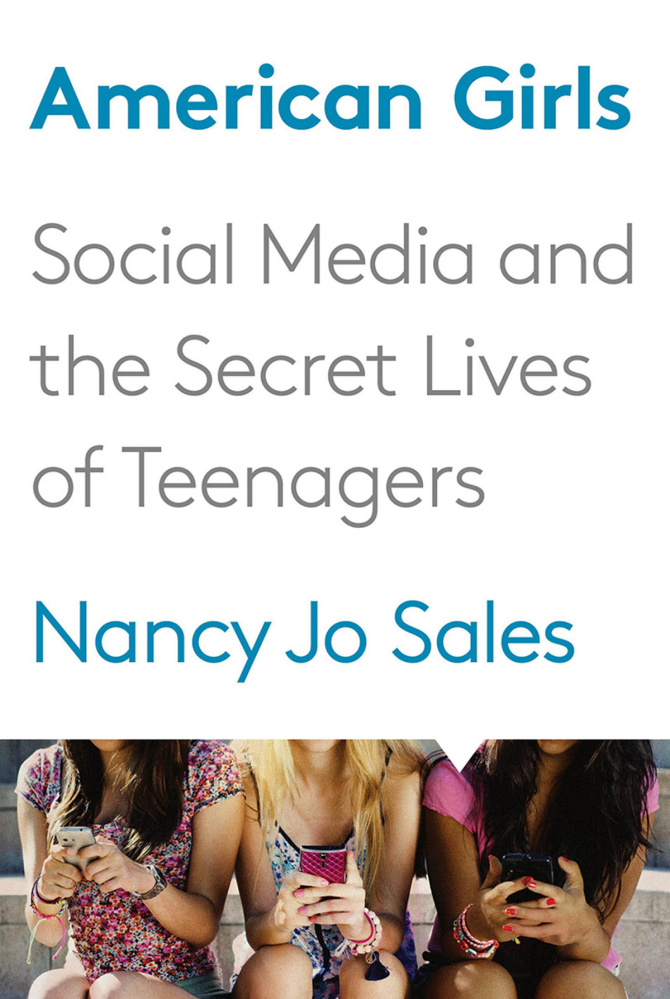“Do you have a finsta?” I asked my daughter, Jane, 15.
“How do you know about finstas?” Jane replied, shocked.
I showed her Nancy Jo Sales’ new book, “American Girls: Social Media and the Secret Lives of Teenagers.” She snatched it and started reading immediately.
Sales, an award-winning journalist and author of “The Bling Ring,” spent 2½ years traveling from coast to coast, interviewing girls age 13 to 19. She wanted to find out what the No. 1 users of social media are doing on their phones 24/7 and explore the effect it is having “on the way they think and act, as well as on how they make friends, the way they date, and their introduction to the world of sex.”
She digs into every aspect of girls’ online lives, revealing myriad disturbing details and introducing a lexicon including “thot” (slut), “turntup” (drunk or high), “duckface” (the pooched-lip expression popular in selfies), “finsta” (a fake Instagram account set up under an alias) and many others unprintable in this newspaper. I would have read it for the vocabulary alone.
Jane knew every term I’d never heard of, every phenomenon and celebrity, from “sink shots” (a type of selfie popularized by Kim Kardashian) to beauty gurus Bethany Mota, Michele Phan and Amanda Steele.
Perhaps the most problematic effect of social media is the fierce emphasis on physical appearance. “For many girls, the pressure to be considered ‘hot’ is felt on a nearly continual basis online,” writes Sales.
“The new word is ‘goals,’ ” Sophia, 13, of Montclair, N.J., tells the author. “You find a really pretty girl on Instagram and you’re like ‘Goals'” – meaning your goal is to have hair, eyebrows and lips like her. “No one cares about being smart anymore. If you’re beautiful, everyone will love you.” Sophia’s mother is an artist, her father is an executive, she is smart and sophisticated – none of that makes a difference.
Because of “goals,” photo-editing apps are as common as Clearasil. More alarmingly, Sales reports that in 2013, 220,000 cosmetic procedures were performed on patients age 13 to 19, partly due to the desire to look better in selfies.
Many topics are explored through interviews and exhaustive research, among them sexting, cyberbullying, porn, feminism, LGBTQ teens and the effects of “sharenting” (92 percent of American children have an online presence before the age of 2, according to one study).
Though only a few pages are devoted to possible remedies, Sales puts some hope in feminism and believes that girls need to read more. She urges Silicon Valley leaders to take responsibility for the effect of their industry on girls’ lives and to start by hiring more women.
Until they do, what it all adds up to is summarized by a 16-year-old in Los Angeles:
“Social media is destroying our lives.”
Then why not quit? asks Sales.
“Because then we would have no life,” replies another girl.
My daughter says things like that, too. Though she found “American Girls” compelling and largely accurate and was relieved that Sales “doesn’t act like Snapchat is the end of the world,” Jane found Sales’ presentation of certain matters “smug.” For example, “You could tell she didn’t think Amanda Steele deserves to be famous, that it’s a total mystery why people would watch her videos. Same with the Kardashians. It’s almost like she’s making fun of girls.”
I hadn’t noticed, probably because I share Sales’ perspective. I believe this is what used to be called “the generation gap” back when I was on the other side of it.
There is much to think and talk about in this book, but it is too long and poorly organized; perhaps it was rushed out since virtual news becomes old so fast. (When I brought up the expression “Got Kik?,” which translates to “do you want to hook up online?” but can also just mean “you are hot!,” Jane said it was so two years ago.)
The chapters are titled “13” through “19,” each focusing on interviews with girls of that age. Many topics come up over and over, and it all begins to run together. On the other hand, the experience of college life and spring break in the chapters about 18- and 19-year-olds is so different from the world of the younger girls that it could have been another book. I would also like to read more about boys – nothing worried me more than the discussion of the way the rule of porn in the lives of adolescent boys is affecting their sexuality.
These reservations don’t change my verdict. If you have a teenage daughter, read “American Girls.” Have her read it, too.
Send questions/comments to the editors.



Success. Please wait for the page to reload. If the page does not reload within 5 seconds, please refresh the page.
Enter your email and password to access comments.
Hi, to comment on stories you must . This profile is in addition to your subscription and website login.
Already have a commenting profile? .
Invalid username/password.
Please check your email to confirm and complete your registration.
Only subscribers are eligible to post comments. Please subscribe or login first for digital access. Here’s why.
Use the form below to reset your password. When you've submitted your account email, we will send an email with a reset code.